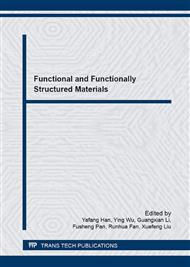[1]
P. S. Murthy, M. M. Naidu. Sustainable management of coffee industry by-products and value addition - A review, Resources, Conservation and Recycling 66 (2012) 45-58.
DOI: 10.1016/j.resconrec.2012.06.005
Google Scholar
[2]
N. Langen. Are ethical consumption and charitable giving substitutes or not? insights into consumers' coffee choice, Food Quality and Preference 22 (2011) 412-421.
DOI: 10.1016/j.foodqual.2011.02.002
Google Scholar
[3]
S. I. Mussatto, L. M. Carneiro, J. P. A. Silva, et al. A study on chemical constituents and sugars extraction from spent coffee grounds, Carbohydrate Polymers 83 (2011) 368-374.
DOI: 10.1016/j.carbpol.2010.07.063
Google Scholar
[4]
B. S. Baek, J. W. Park, B. H. Lee, et al. Development and application of green composites: using coffee ground and bamboo flour, Journal of polymers and the environment 21 (2013) 702-709.
DOI: 10.1007/s10924-013-0581-3
Google Scholar
[5]
I. Chiyanzy, M. Brienzo, M. G. Aparicio, et al. Spent coffee ground mass solubilisation by steam explosion and enzymatic hydrolysis, Journal of chemical technology and biotechnology 90 (2013) 449-458.
DOI: 10.1002/jctb.4313
Google Scholar
[6]
B. Soares, N. Gama, C. S. R. Freire, et al. Spent coffee grounds as a renewable source for ecopolyols production, Journal of chemical technology and biotechnology (2014).
DOI: 10.1002/jctb.4457
Google Scholar
[7]
H. Ribeiro, J. Marto, S. Raposo, et al., From coffee industry waste materials to skin-friendly products with improved skin fat levels, European journal of lipid science and technology 115 (2013) 330-336.
DOI: 10.1002/ejlt.201200239
Google Scholar
[8]
A. Nonthakaew, N. Matan, T. Aewsiri, et al. Antifungal activity of crude extracts of coffee and spent coffee ground on areca palm leaf sheath (Areca catechu) based food packaging, Packaging technology and science (2015).
DOI: 10.1002/pts.2132
Google Scholar
[9]
D. Garcia-Garcia, A. Carbonell, M. D. Samper, et al. Green composites based on polypropylene matrix and hydrophobized spend coffee ground (SCG) powder, Composites part B: engineering 78 (2015) 256-265.
DOI: 10.1016/j.compositesb.2015.03.080
Google Scholar
[10]
H. K. Lee, Y. G. Park, T. Jeong, et al. Green nanocomposites filled with spent coffee grounds, Journal of applied polymer science 132 (2015).
DOI: 10.1002/app.42043
Google Scholar


